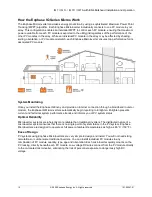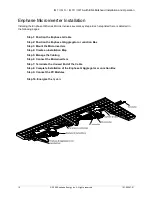
IQ 7 / IQ 7+ / IQ 7X / IQ 7A with EN4 Bulkhead Installation and Operation
© 2020 Enphase Energy Inc. All rights reserved.
141-00047-01
6
IQ 7 Series Microinverter Safety Instructions
General Safety
DANGER
: Risk of
electric shock.
Risk of fire.
Only use electrical system components approved for wet locations.
Only qualified personnel should install, troubleshoot, or replace Enphase Microinverters or Enphase
Q Cable and Accessories.
Ensure that all AC and DC wiring is correct and that none of the AC or DC wires are pinched,
shorted or damaged. Ensure that all AC junction boxes are properly closed.
Do not exceed the maximum number of microinverters in an AC branch circuit as listed in the
manual. You must protect each microinverter AC branch circuit with a 20 A maximum breaker or
fuse as appropriate.
DANGER
: Risk of
electric shock.
Do not use Enphase equipment in a manner not specified by the manufacturer. Doing so may cause
death or injury to persons, or damage to equipment.
Be aware that installation of this equipment includes risk of electric shock.
The DC conductors of this photovoltaic system are ungrounded and may be energized.
Always de-energize the AC branch circuit before servicing. While connectors are rated for
disconnect under load, Enphase does not recommend disconnecting the DC connectors under load.
WARNINGS:
Before installing or using the Enphase Microinverter, read all instructions and cautionary markings
in the technical description, on the Enphase equipment and on the photovoltaic (PV) equipment.
Do not connect Enphase Microinverters to the grid or energize the AC circuit(s) until you have
completed all of the installation procedures and have received approval from the electrical utility.
When the PV array is exposed to light, DC voltage is supplied to the power conversion equipment
(PCE).
Risk of equipment damage. Enphase male and female connectors must only be mated with the
matching male/female connector.
NOTES:
To ensure optimal reliability and to meet warranty requirements, install the Enphase equipment
according to the instructions in this manual.
The AC and DC connectors on the cabling are rated as a disconnect only when used with an
Enphase Microinverter.
Use recommended disconnection tools to prevent damage to the microinverter
Protection against lightning and resulting voltage surge must be in accordance with local standards.
Perform all electrical installations in accordance with all applicable local electrical codes, such as:
the Canadian Electrical Code, Part 1; ANSI requirements; and NPFA 70 (NEC).
Microinverter Safety
WARNING
: Risk of
skin burn.
The chassis of the Enphase Microinverter is the heat sink. Under normal operating conditions, the
temperature could be 20° C above ambient, but under extreme conditions the microinverter can
reach a temperature of 90° C. To reduce risk of burns, use caution when working with
microinverters.
DANGER
: Risk of
fire.
The DC conductors of the PV module must be labeled “PV Wire” or “PV Cable” when paired with
the Enphase Microinverter.
DANGER
: Risk of
electric shock. Risk
of fire.
Only qualified personnel may connect the Enphase Microinverter to the utility grid.
Do not attempt to repair the Enphase Microinverter; it contains no user-serviceable parts. If it fails,
contact Enphase to obtain a return merchandise authorization (RMA) number and start the
replacement process. Tampering with or opening the Enphase Microinverter will void the warranty.
WARNING
: Risk of
equipment damage
Install the microinverter under the PV module to avoid direct exposure to rain, UV, and other
harmful weather events. Always install the microinverter bracket side up. Do not mount the
microinverter upside down. Do not expose the AC or DC connectors (on the Enphase Q Cable, PV
module, or the microinverter) to rain or condensation before the connectors are mated.
The maximum open circuit voltage of the PV module must not exceed the specified maximum input
DC voltage of the Enphase Microinverter.







































